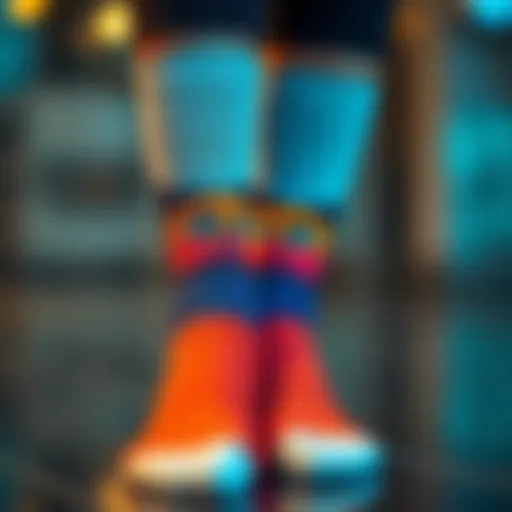Rattan Spheres: Aesthetic and Practical Insights
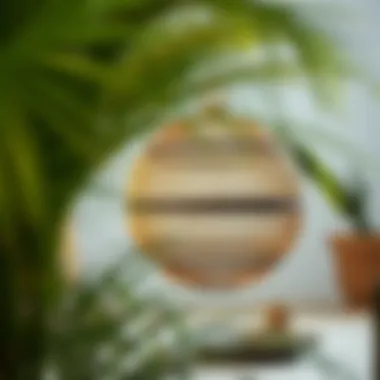

Intro
Rattan spheres and balls have emerged as a captivating element in both home decor and fashion accessories in recent years. These items do not just serve practical purposes; they also hold a unique aesthetic appeal that bridges the gap between function and visual delight. This exploration will delve into the rich history, cultural significance, and modern applications of rattan spheres, laying out a comprehensive guide for designers, stylists, and anyone keen on integrating them into their work.
From rustic interiors to high-fashion statements, rattan's lightweight and durable characteristics make it a coveted choice. The versatility of these structures can transform a mundane space into a sanctuary while also being an eye-catching piece in various outfits. The growing trend of sustainability in design has further endeared rattan to environmentally-conscious consumers and creators alike. Let's embark on a journey through the dimensionality of rattan spheres, starting with their current relevance in fashion trends.
Preface to Rattan Spheres
Rattan spheres are more than just decorative items; they encapsulate a blend of beauty and functionality that is increasingly valued in today's design landscape. These spheres, crafted from the long, flexible stems of rattan palms, offer aesthetic appeal alongside practical uses that appeal to designers, stylists, and even homeowners. Understanding the significance of rattan spheres can inform choices in home decor, fashion accessories, and event setups, making them versatile components in various creative endeavors.
Definition and Characteristics
Rattan spheres are round objects made from rattan, distinguished by their lightweight yet sturdy structure. Their surface, often woven in intricate patterns, adds a tactile dimension that can enhance the sensory experience of a space. They come in varying sizes, from small decorative accents to larger statement pieces, allowing for creative versatility in both home decor and fashion.
One notable characteristic of rattan is its natural finish, which tends to give these spheres an organic warmth. This adaptability makes them highly appropriate for a range of design aesthetics, from bohemian to modern minimalist. It is worth noting, however, that not all rattan spheres are created equal. The quality can depend greatly on the craftsmanship and materials employed during production. As such, discerning buyers should pay close attention to the details of the weave, the finish, and the overall uniformity of the item.
Cultural Origins of Rattan
The cultural roots of rattan spheres stretch far across the globe, primarily within the tropical regions of Southeast Asia where rattan species thrive. Historically, various indigenous communities have utilized rattan not only for making furniture but also for creating attire, tools, and decorative items. The intricate craftsmanship involved in these creations often carries a story—each piece is typically shaped by local customs, materials, and techniques handed down through generations.
In many cultures, the use of rattan is more than just a matter of utility; it's a reflection of identity and heritage. For instance, in the Philippines, artisans meticulously weave rattan into baskets and sculptures that are significant in local art forms. As we step forward in time, the global appreciation for these materials has surged, fostering a revitalization of traditional crafts and placing rattan back in the spotlight.
Rattan Balls in Design
Rattan balls are more than mere decorative items; they are a perfect blend of aesthetic delight and practicality. The rising trend of integrating natural materials into design has spotlighted rattan as a versatile choice for interiors, elevating both functionality and visual appeal. In recent years, they have emerged as a favored element among designers and decorators who appreciate their ability to enhance spaces with organic warmth while serving various purposes.
In the ever-evolving design sphere, rattan holds a unique position. From fashion runways to interior exhibitions, it reflects a shift toward sustainability while maintaining a chic air. The popularity of rattan balls showcases cultural influences, practical applications, and their ability to cater to the needs of contemporary design without sacrificing style. Let's delve deeper into this fascinating aspect of design, examining the aesthetic value they bring to home decor, as well as their functional uses.
Aesthetic Value in Home Decor
Rattan balls find their charm primarily in the visual richness they introduce to home interiors. Imagine a spacious living room; the incorporation of rattan spheres can transform the entire atmosphere. Their natural tones add a touch of earthiness, complementing a variety of color schemes—from muted palettes to vibrant bursts. This adaptability makes rattan a go-to selection for those who want to inject a sense of organic beauty into their space.
In essence, rattan balls serve as sculptural elements, drawing the eye and sparking conversation. For instance, a cluster of different sized rattan spheres on a coffee table can create an inviting focal point. The interplay of light and shadow on their textured surfaces adds a dynamic quality that is nothing short of captivating.
Moreover,
- Versatility: Rattan comes in various shapes, sizes, and finishes, allowing for custom decor that caters to any personal taste.
- Timelessness: Their classic look remains in vogue, transcending seasonal trends and allowing for long-term investment in decor.
- Warmth: Unlike colder materials like metal or glass, rattan embodies a welcoming feel that adds coziness to any space.
The use of rattan balls in decor isn't cookie-cutter either. They can be easily incorporated into untraditional spaces, such as outdoor patios and open-air settings, where they can inspire a relaxed, bohemian vibe. Thus, whether displayed alone or grouped, rattan adds character and warmth, making each space uniquely personal.
Functional Uses in Interior Design
Rattan balls are not just a pretty face; they also boast practical benefits that enhance interior function. Firstly, they can double as storage not just a decoration—but creative storage solutions. Large rattan balls can discreetly hold items like blankets or magazines, seamlessly blending functionality with style.
Additionally, rattan balls often serve as versatile, lightweight accents in various design schemes. They can be used in:
- Table Centerpieces: Arranged in decorative bowls or trays, they can breathe life into a tabletop without overwhelming the view.
- Playful Lighting Fixtures: Hanging rattan spheres can diffuse light beautifully, creating an inviting ambience wherever they’re placed.
- Accents in Spatial Design: Their ability to fit seamlessly into various settings allows for creative placement, providing depth and variation in interior design elements.
In practical terms, rattan materials are generally lightweight and easy to move around. This quality can give designers more flexibility in arranging spaces, enabling a quick shift from one style to another without substantial effort.
The rise of rattan balls in the realm of interior design clearly demonstrates that the boundaries of function and aesthetics are increasingly blurred. As they each bring something to the table—whether it’s visual interest or practical utility—rattan continues to solidify its role in modern decor, fueling trends that emphasize individuality and sustainable choices in design.
By integrating rattan into decor, designers can cultivate a harmonious blend of comfort and style that resonates deeply with both visitors and inhabitants alike.
"Rattan embodies not just design but a lifestyle, a choice that stands for sustainability wrapped in beauty."
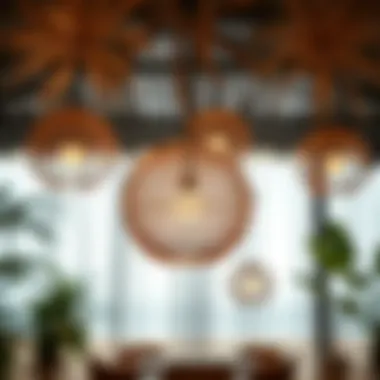

Artisanal Techniques and Craftsmanship
Craftsmanship goes beyond just the physical creation of rattan spheres; it captures the essence of tradition, culture, and meticulous attention to detail. This section emphasizes the vital role artisanal techniques play in both the aesthetic appeal and the practical utility of rattan designs. Understanding these techniques not only enhances our appreciation of objects made from rattan but also supports sustainable practices that benefit communities and the environment.
Materials and Manufacturing Processes
Creating rattan spheres begins with understanding the materials involved. Primarily, the material used is rattan, a climbing palm that is known for its unique properties – flexibility, resilience, and light weight.
- Harvesting Techniques: The harvesting of rattan needs skill; it is generally cut by hand to ensure that the full length of the vine is preserved, which plays a crucial role in the strength and flexibility of the final product. This method does not only maintain the quality but also promotes sustainability by encouraging careful resource management.
- Preparation of Rattan: Once harvested, the rattan is prepared for crafting. This process involves stripping the outer skin and soaking the inner core in water to make it pliable. This soaking process can take anywhere from several hours to a few days, depending on the thickness of the rattan. It’s important, as it ensures that during the weaving process, the material remains workable and doesn’t break.
- Weaving Techniques: The actual creation of rattan spheres involves intricate weaving methods. Artisans often employ various patterns such as the spiral weave or checkerboard pattern, impressed by their cultural heritage. Each artisan may have their own unique approach, leading to a variety of designs that can appeal to different tastes.
Many artisans also integrate natural dyes into the process, which can add a bohemian aesthetic to the spheres while remaining environmentally friendly, as these dyes are non-toxic and biodegradable.
The Role of Artisans in Creation
Artisans are the backbone of this craft, their skills honed through generations.
"A true artisan sees their craft not just as a means to an end, but as a legacy to be passed down through time."
These craftspeople not only create durable products but also infuse their pieces with cultural significance. Their stories and traditions are interwoven into every rattan sphere they craft, enhancing value beyond mere aesthetics. To further illustrate:
- Cultural Influences: Many artisans draw inspiration from their surroundings or heritage, meaning that rattan spheres can reflect regional styles or stories.
- Community Impact: Supporting artisans also uplifts local communities, fostering economic development and preserving age-old crafting techniques. By valuing artisanal products, consumers contribute to sustainability and eco-friendliness.
In short, the craftsmanship of rattan spheres reveals much more than the simple act of weaving; it's about cultural conservation, sustainability, and the celebration of human ingenuity. Whether nestled on a shelf or hanging as part of an elaborate interior design scheme, these spheres bear witness to the labor and love of their makers.
Practical Applications of Rattan Spheres
Rattan spheres hold a unique place in both the aesthetic and functional realms of design. Their versatility makes them more than just decor; they are capable of enriching various facets of life. The charm of these natural creations lies in their blend of beauty and utility. Whether gracing a living room or making a statement at an event, rattan spheres are a testament to thoughtful craftsmanship and imaginative design. This section explores their practical applications in two primary areas: fashion accessories and event decor.
Use in Fashion Accessories
The emergence of rattan spheres in the fashion industry signifies a growing trend toward sustainable, eco-friendly materials that do not compromise on style. Designers are harnessing the natural allure of rattan to craft accessories that appeal to those with a keen eye for both aesthetics and ethics. Rattan spheres can be shaped into stunning earrings, necklaces, and bracelets, serving not just as embellishments but as conversation starters.
- Natural Appeal: The organic look of rattan adds a rustic yet modern edge to accessories. Each piece has its unique characteristics – the varied textures and colors of the fibers speak to a handmade quality that mass-produced items lack.
- Lightweight yet Durable: Rattan spheres are exceptionally light, which makes them comfortable to wear. At the same time, they possess a remarkable strength that stands the test of time, allowing them to be used in various designs without fear of breakage.
- Eco-Conscious Choices: As consumers become increasingly eco-aware, rattan serves as a perfect alternative to plastic and other unsustainable materials. Moreover, using rattan can contribute to ethical fashion practices, supporting local artisans and communities.
Designers can find new ways to incorporate these spheres into their collections. By adding leather straps, metal accents, or even fabric elements, the possibilities are nearly limitless. As styles evolve, rattan can be part of seasonal trends or timeless classics, making a significant impact in a niche market.
Integration into Event Decor
When it comes to event decor, rattan spheres provide a distinct appeal that enhances any setting. Whether used in weddings, corporate events, or casual gatherings, these versatile elements can be integrated into decor themes effortlessly.
- Centerpieces and Arrangements: Due to their size and shape, rattan spheres can serve as eye-catching centerpieces. They can be combined with flowers, candles, or lights to create unique focal points on tables. When placed in groups, they draw attention and add texture to the environment.
- Outdoor Ambiance: For outdoor events, these spheres can be hung from trees or structures, adding a playful touch that harmonizes with nature. When lit from within, rattan spheres can transform an evening gathering into a magical experience, casting delightful shadows and warm light.
- Flexibility in Themes: Rattan’s natural tones make it suitable for rustic, bohemian, or even modern chic themes, allowing it to blend easily with various decor styles. This adaptability means that planners can use rattan spheres across different events without worrying about mismatches.
Rattan spheres bring elegance and quiet charm to events, complementing rather than overpowering the overall aesthetic. They embody a subtle sophistication that is appreciated by guests and hosts alike.
Sustainability Aspects of Rattan
Rattan, often overshadowed by more mainstream materials, offers a striking case of sustainability and ecological responsibility in design. As an increasingly relevant topic, the sustainability of rattan spheres remains central to conversations around eco-friendly design. The essence of rattan's sustainability hinges on both its sourcing and its environmental impact.
Sourcing Sustainable Rattan
Sourcing sustainable rattan is not just about picking a plant from the wild; it involves understanding the lifecycle, cultivation practices, and community impact of this versatile material. Rattan typically grows in tropical climates, which often means that its harvesting is intertwined with local economies. When sourced responsibly, rattan can be a boon for these communities.
- Ethically Managed Forests: Sustainable harvesting ensures that rattan is collected from forests managed in line with environmental regulations. This approach helps maintain biodiversity and promotes healthy ecosystems.
- Community Engagement: In many regions, local communities manage rattan production, so supporting responsible companies often means uplifting these communities economically. Businesses that prioritize ethical sourcing create a ripple effect, enhancing livelihoods.
- Certification Programs: Various certification programs can help identify sustainably sourced rattan. Look for labels from organizations that assess the environmental and social impacts of rattan harvesting.
By ensuring that rattan is sourced sustainably, designers and consumers alike can play a role in reducing ecological footprints.
Environmental Benefits of Rattan
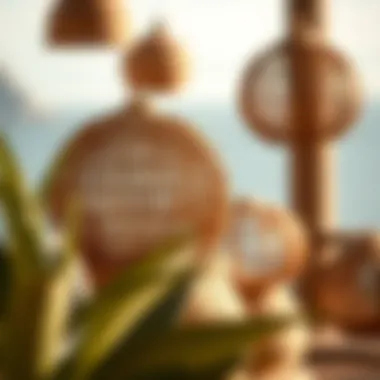

Rattan is much more than just a pretty face in the world of design. It holds significant advantages for our ecosystems. The environmental benefits of rattan speak volumes about its ability to contribute positively to sustainable practices.
- Carbon Sequestration: Rattan plants are excellent at absorbing carbon dioxide. They effectively capture carbon emissions, aiding in the fight against climate change. When using rattan, we are not only utilizing a resource but also choosing one that can help mitigate our impact on the planet.
- Minimal Waste: The manufacturing processes associated with rattan are typically low-waste. Craftspersons utilize nearly every part of the rattan plant, reducing unnecessary waste that often plagues synthetic material industries.
- Biodegradability: Unlike plastic or synthetic materials, rattan is biodegradable. At the end of its life cycle, rattan will break down naturally, returning to the earth without leaving harmful residues.
"Choosing rattan is not just a style statement; it's a vote for sustainable beauty that respects our planet."
In summation, the sustainability aspects of rattan spheres go beyond aesthetics, deepening their significance in both fashion and home decor. The careful sourcing of rattan from managed forests, coupled with the material's intrinsic environmental benefits, underscores why this natural resource deserves a prominent place in sustainable design discussions.
For further reading on sustainable practices and the importance of sourcing materials responsibly, please refer to Wikipedia, or visit sustainability-focused forums like Reddit’s Green Living.
Engaging with these ideas can inspire fashion designers, retailers, and influencers to champion rattan not only as a stylish choice but as a responsible one.
Trends in Rattan Design
In recent years, rattan spheres have made a significant splash in both home decor and fashion, capturing the attention of designers and consumers alike. Understanding the trends in rattan design is crucial, as it not only reflects the evolution of aesthetic preferences but also showcases the practical applications that resonate with sustainable practices. The increasing interest in natural materials, particularly in an age where sustainability is more than just a buzzword but a way of life, makes rattan an attractive choice.
Current Trends in Home Decor
Today's design enthusiasts are moving towards a minimalist yet warm aesthetic that celebrates nature. Rattan spheres are at the forefront of this trend, beckoning to those who wish to inject organic elements into their spaces. Here are some noteworthy trends:
- Natural Textures: With the surge of interest in tactile materials, rattan's warm textures serve as a perfect balance to sleek modern finishes. Designers are increasingly using rattan in lamps, wall hangings, and even furniture pieces.
- Bohemian Influences: The boho chic look continues to reign strong, encouraging the use of rattan in a more playful manner. Hanging rattan spheres as light fixtures or accent pieces add flair without overwhelming a room's atmosphere.
- Sustainable Choices: As consumers become more eco-aware, there's an undeniable shift towards sustainable materials. Rattan, known for its fast-growing nature and low ecological footprint, is appealing to those who prioritize environmental friendliness in their decor selections.
"Rattan is not merely a trend; it’s a testament to the shift in mindset towards sustainable living, proving that beauty can thrive with conscious choices."
This movement sees rattan spheres being integrated not just as decorative pieces but also as components that promote mindful consumption.
Fashion-forward Uses of Rattan
Rattan is increasingly woven into the world of fashion. In a market where sustainability and style must go hand-in-hand, designers are exploring innovative ways to feature rattan as a mainstay in accessories and apparel. Some clear pathways here include:
- Statement Accessories: Fashion-forward individuals are gravitating towards rattan handbags, jewelry, and footwear that offer a unique twist. These pieces often combine rattan with other materials, creating bold contrasts while maintaining an earthy appeal.
- Runway Influence: Recent fashion shows have highlighted rattan-inspired lines, where unique textures play a pivotal role. Whether it’s a rattan belt or a piece of outerwear woven intricately to include rattan elements, the material is proving its versatility.
- Seasonal Collections: Designers are launching seasonal collections that play up rattan’s airy feel for summer wear and cozy aesthetics in cooler months, promoting a harmonious blend of functionality and style.
Exploring these modern trends in rattan design highlights not just a shift towards natural materials but presents a broader canvas for creativity that resonates with a discerning audience. As rattan spheres continue to evolve in their applications, they promise to remain a staple in both our homes and our wardrobes.
Comparative Analysis with Other Materials
In the realm of design, understanding materials is crucial. This section takes a closer look at rattan, examining its position compared to other commonly used materials. When it comes to aesthetic appeal and practicality, choices matter greatly. This is especially true for designers and retailers who seek to distinguish themselves in a competitive market. By comparing rattan spheres to synthetic alternatives and evaluating their durability and maintenance, we can appreciate rattan's unique characteristics more deeply.
Rattan vs. Synthetic Alternatives
Rattan, sourced from tropical vines, stands apart from synthetic materials in numerous ways. Rattan spheres often inherit a natural charm that synthetic counterparts simply cannot replicate. The warmth of organic textures adds a layer of depth to designs that artificial materials struggle to match. While some synthetic options might boast a higher initial durability, they often lack the life and character provided by natural materials.
- Natural Aesthetic: Rattan's earthy tones and varied textures contribute to a warm and inviting atmosphere, ideal for home decor.
- Sustainability: Unlike plastic or other synthetic materials, rattan is renewable and biodegradable. This makes it an attractive choice for environmentally conscious designers.
- Versatility: Rattan spheres can seamlessly fit into various aesthetics, from boho to modern minimalist, while synthetic options may often lean toward a particular style, limiting their versatility.
However, synthetic materials do have their merits, especially in terms of maintenance. For instance, while rattan might require occasional refinishing, synthetic options might only need a quick wipe with a damp cloth. Designers should weigh these considerations carefully when selecting materials for their projects.
Durability and Maintenance Considerations
Rattan is often celebrated for its strength and flexibility but does require some upkeep to ensure longevity. In contrast, synthetic materials frequently shine for their low-maintenance appeal. Understanding the durability and maintenance of rattan spheres illuminates the care needed to maintain their beauty.
- Resistance to Wear: While rattan can withstand significant wear and tear, it’s important to avoid excessive moisture, which can warp the fibers.
- Cleaning: Regular dusting is advisable for rattan pieces, while synthetic alternatives can often be cleaned more easily without worrying about potential damage.
- Long-Term Investment: Investing in rattan pieces can pay dividends over time as their character deepens with age, unlike many synthetic materials, which may fade or lose their appeal.
Rattan has certain quirks that should not be overlooked. This includes its ability to breathe and prevent buildup of moisture – a crucial benefit in humid climates. On the other hand, synthetic options, while designed for resilience, may not offer the same innate benefits as rattan. Ultimately, it boils down to a balance of aesthetic values versus practical conveniences.
"Choosing the right materials communicates not just a style, but a philosophy behind design."
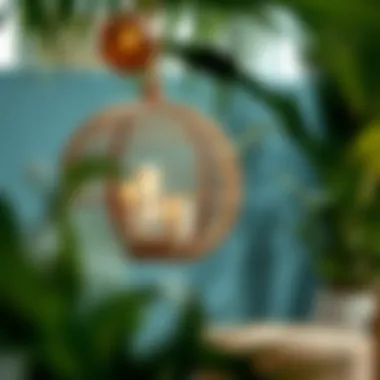

In summary, the choice between rattan and synthetic alternatives hinges on what matters most for a given project. Rattan's beauty, coupled with its sustainability, offers a compelling argument for use in both fashion and decor settings. Designers would do well to consider their audience's values and preferences before making a material selection.
Exploring Global Varieties of Rattan
Understanding the different global varieties of rattan is essential when discussing their aesthetic and functional values. Rattan plants flourish in humid tropical climates, making regions such as Southeast Asia, Africa, and parts of South America prime sources for this versatile material. Each species possesses its unique traits—some are more suitable for crafting durable furniture, while others may excel in intricate decorative pieces. This diversity not only enriches design but also champions local craftsmanship, allowing artisans to blend traditional techniques with contemporary aesthetics.
Notable Species in Design
When considering rattan for design purposes, a few standout species consistently come to the forefront. Two of the most recognized varieties are Calamus rudentis and Eremospatha macrocarpa.
- Calamus rudentis: This species is especially prized for its flexibility and strength, making it a favorite for furniture and larger decor items. Its slender stalks can be bent and shaped with ease, fitting seamlessly into various design contexts.
- Eremospatha macrocarpa: Known for its stunning appearance, this species is often chosen for decorative purposes. Its unique growth pattern and visual texture lend itself to beautiful aesthetic applications, adding a touch of nature to any space.
These species provide a canvas for creativity, inviting designers to experiment with various forms, textures, and finishes. Understanding the characteristics of rattan species enables designers to make informed choices that align with their creative visions.
Regional Crafting Techniques
Crafting techniques vary significantly between regions, reflecting cultural heritage and resource availability. Each area where rattan is harvested has its own traditional methods that not only respect the material but also imbue the finished products with community identity.
- Southeast Asia: In places like Indonesia and the Philippines, artisans utilize techniques passed down through generations. They often employ intricate weaving methods, allowing for complex designs that exhibit high craftsmanship. The process may involve hand-dyeing fibers using natural materials, producing stunning color variations in the finished product.
- Africa: Craftsmanship in Africa tends to focus on durability and functionality. Artisans here often combine rattan with other materials like wood or metal for added strength. The furniture produced is not just aesthetically pleasing but also built to withstand the rigors of everyday use.
By exploring these regional differences, designers and consumers can appreciate the cultural narratives intertwined with every rattan piece. Choosing items that showcase specific crafting techniques not only enhances the design but also supports the artisans' livelihoods and sustains cultural practices.
"Rattan isn't just a material; it's a living link to artistry shaped by geography and tradition."
In summary, appreciating the global varieties of rattan involves recognizing the unique species and the regional craftsmanship behind them. This understanding not only enhances design prowess but also celebrates the rich heritage that these materials carry.
Future of Rattan in Design
The future of rattan in design holds considerable promise, weaving together creativity, sustainability, and functionality. As designers and consumers alike pivot towards eco-friendly options, rattan stands out as a versatile material that blends aesthetic charm with practical use. With the ongoing trend of sustainability influencing various industries, understanding the trajectory of rattan not only illuminates its potential but also emphasizes its crucial role in modern design. Here we’ll explore key innovations and anticipated market trends that could shape the future landscape of rattan.
Innovations in Rattan Crafting
Innovations in crafting techniques are breathing new life into the age-old practice of rattan weaving. Artisans and manufacturers are experimenting with a variety of methods that push the boundaries of traditional designs. New technologies, such as laser cutting and 3D weaving, allow for more intricate patterns and shapes, enhancing the overall aesthetic appeal of rattan products. Additionally, lightweight but durable finishes are being developed to improve the usability of rattan items, particularly for outdoor settings.
Moreover, collaborations between designers and artisans are generating unique designs that cater to contemporary tastes while respecting traditional craftsmanship. This fusion not only preserves cultural heritage but also attracts a modern audience, eager for products that tell a story. Developers are also exploring bio-based coatings that enhance rattan’s resistance to the elements, ensuring pieces are capable of enduring various environmental conditions without compromising their beauty.
Potential Market Trends
As consumer preferences shift towards sustainable lifestyle choices, the market for rattan products is expected to grow significantly. Here are some potential trends to keep an eye on:
- Minimalism: Rattan’s organic texture complements the minimalist aesthetic, which is gaining traction in home decor. Clean lines and understated designs make rattan items appealing today as they focus on simplicity and functionality.
- Outdoor Living Spaces: With a rise in remote working, outdoor spaces are becoming extensions of our homes. Rattan’s lightweight nature makes it ideal for patio and garden furniture that balances both comfort and style.
- Eco-Conscious Consumerism: Growing awareness of environmental impacts means that consumers are favoring brands that utilize sustainable materials, like rattan. Products made with responsibly sourced rattan will likely see increased demand.
"Sustainability isn't just a trend; it's a lifestyle that will shape the market's future landscape."
- Customization: As personalization becomes essential for consumers, options that allow for bespoke design and customization will elevate rattan products. Offering consumers the chance to personalize their items creates greater demand and enhances perceived value.
In summary, the fusion of traditional craftsmanship with modern innovations positions rattan as a leader in sustainable design moving forward. The evolving preferences of designers and consumers alike point to a vibrant future for rattan, one where it not only serves practical purposes but continues to inspire and beautify our spaces.
End and Final Thoughts
The journey through the world of rattan spheres has been both intriguing and enlightening. These unique creations serve not only as stunning decorative elements but also embody practicality in various domains. Understanding their aesthetic appeal, along with their integration into everyday life, is crucial for anyone involved in fashion or interior design.
Summary of Insights
Throughout this article, several key points have emerged concerning rattan spheres. First, their versatility in both home decor and as fashion items cannot be overstated. From serving as a centerpiece for a chic living room to finding a home as a stylish accessory in a designer outfit, rattan spheres bridge the gap between form and function. Furthermore, the craftsmanship behind each piece adds an element of narrative that speaks to their cultural and artisanal roots. The sustainable aspects of rattan also hold immense significance, particularly in today's environmentally-conscious marketplace. As consumers increasingly seek eco-friendly options, these spheres align perfectly with values around sustainability and responsible sourcing.
"Rattan spheres capture the essence of nature, transforming it into aesthetic and utilitarian forms that resonate with contemporary sensibilities."
Encouragement for Further Exploration
As we conclude this exploration, there's a world of possibilities waiting to be discovered with rattan. Whether you are a fashion designer looking for the next trend or a home decorator seeking to elevate your space, embracing rattan spheres can inspire innovation. I encourage everyone to delve deeper into the various applications of this material. Attend local artisan markets, participate in workshops, or even consider incorporating some rattan elements into your own craft projects. The potential to redefine rattan's role in design is vast, and one never knows what creative sparks might ignite through further exploration.
In closing, approaching rattan as both a material and a design element invites an adventure rich with cultural significance and artistic growth. Consider how this natural wonder can play a role in your work or personal style, and let the exploration lead you to new heights in aesthetic expression.

